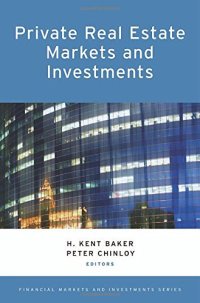
Ebook: Private Real Estate Markets and Investments
Author: H. Kent Baker Peter Chinloy
- Tags: Public Finance Economics Business Money Investing Analysis Strategy Bonds Commodities Futures Introduction Mutual Funds Online Trading Options Real Estate Stocks Investments Securities New Used Rental Textbooks Specialty Boutique
- Series: Financial Markets and Investments
- Year: 2014
- Publisher: Oxford University Press
- Edition: 1
- Language: English
- pdf
This book provides an overview of private real estate markets and investments. The 14 chapters are divided into three sections for conventional and alternative real estate investments and regulatory issues. Conventional investable real assets examined are retail spaces, apartments, offices, and industrial facilities owned by corporate entities. Alternative real estate assets are uniquely and extensively addressed. These include healthcare, both for facilities and the pricing to make it an investable asset; infrastructure contains roads, bridges, and public utilities; and resources are in land, agriculture, oil, and gas. The regulatory section includes appraisal and valuation, brokerage and transaction costs, sustainability, and green buildings. Readers should gain a greater appreciation of what is needed to be successful when investing in private real estate markets.
The share of real estate in institutional portfolios has risen above a previous 5% target, as investors avoid the risks of low interest rates. The world's wealth is shifting to emerging markets where real estate is already a dominant asset class and public securities markets are limited. Institutions with long horizons avoid publicly traded markets because they want to capture any premium from illiquidity. Real estate involves local and cultural restrictions on land usage, sustainability and on the regulation of the illiquidity.
For information about public real estate, read Public Real Estate Markets and Investments.
The share of real estate in institutional portfolios has risen above a previous 5% target, as investors avoid the risks of low interest rates. The world's wealth is shifting to emerging markets where real estate is already a dominant asset class and public securities markets are limited. Institutions with long horizons avoid publicly traded markets because they want to capture any premium from illiquidity. Real estate involves local and cultural restrictions on land usage, sustainability and on the regulation of the illiquidity.
For information about public real estate, read Public Real Estate Markets and Investments.
Download the book Private Real Estate Markets and Investments for free or read online
Continue reading on any device:

Last viewed books
Related books
{related-news}
Comments (0)